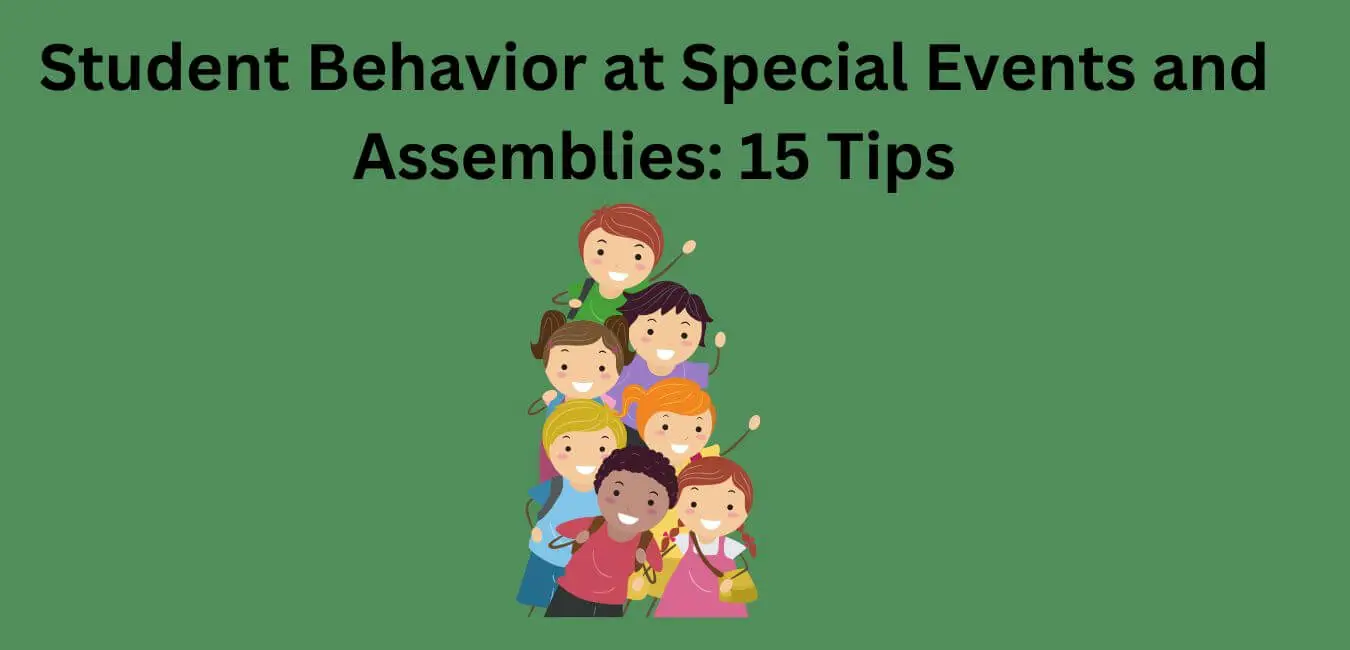When it comes to special events and assemblies, managing student behavior can be quite a challenge.
The excitement, anticipation, and change in routine can often result in chaos, making it difficult for teachers and staff to maintain order and ensure a positive experience for everyone involved.
If you’ve ever struggled with keeping students calm, focused, and behaving appropriately during these types of events, you’re not alone.
In this blog post, we’ll be sharing 15 tips to help you effectively manage student behavior during special events and assemblies, ensuring a smoother and more enjoyable experience for all.
From setting clear expectations to utilizing engaging activities, these strategies will empower you to create an environment that fosters respectful behavior, active participation, and lasting memories.
So, let’s dive in and explore these tried and true tips that can make a world of difference in your next school event or assembly.
- Strategies to effectively manage student behavior during special events and assemblies
- 1. Use positive reinforcement
- 2. Create clear expectations and rules beforehand
- 3. Provide visual aids to remind students of expectations
- 4. Assign seating arrangements strategically
- 5. Have a designated staff member monitor behavior
- 6. Use nonverbal cues to redirect misbehavior
- 7. Have a backup plan in case behavior becomes disruptive
- 8. Utilize peer pressure and positive peer modeling
- 9. Praise good behavior publicly
- 10. Address misbehavior privately
- 11. Use appropriate consequences for misbehavior
- 12. Allow for breaks and movement during long events
- 13. Provide a structured activity for students during downtime
- Conclusion
Strategies to effectively manage student behavior during special events and assemblies
1. Use positive reinforcement
Using positive reinforcement is a highly effective method for managing student behavior during special events and assemblies. This technique involves rewarding desired behaviors and achievements, which motivates students to repeat them in the future.
By focusing on recognizing and reinforcing positive actions, teachers can create an encouraging and supportive environment during these events.
To implement positive reinforcement, educators can use a combination of verbal praise, nonverbal cues, and tangible rewards to acknowledge and appreciate students’ appropriate behavior.
For example, a teacher might give a thumbs-up, a clap, or a quiet “well done” to a student who is sitting quietly and attentively during an assembly. They can also offer small incentives, such as extra free time or the chance to participate in a fun activity, as a reward for good behavior.
It is crucial to deliver these reinforcements promptly, so students can easily associate their actions with the positive consequence.
Tailoring the reinforcement to each student’s preferences and needs is key to ensuring its effectiveness and maintaining engagement during special events and assemblies.
2. Create clear expectations and rules beforehand
Creating clear expectations and rules beforehand is essential for managing students effectively during special events and assemblies. Teachers should collaborate and establish guidelines that promote positive behaviors and maintain order in these unique settings.
By setting expectations ahead of time, students are aware of what is required of them, helping to eliminate confusion and enabling a smoother experience for all involved.
To ensure success, these expectations and rules should be simple, concise, and age-appropriate, making them easy for students to understand and follow.
Teachers may want to involve their students in creating these rules to ensure they feel invested in and accountable for their actions during special events. It’s vital for teachers to regularly review and reinforce these expectations to ensure that students are consistently exhibiting appropriate behavior.
By doing so, teachers can create a positive atmosphere where students can enjoy special events while maintaining proper decorum.
3. Provide visual aids to remind students of expectations
One effective way to manage student behavior during special events and assemblies is by providing visual aids that clearly outline and remind students of the expected behavior. These visual aids can be displayed in a prominent location, where students can easily refer to them.
Visual aids can include posters, signs, or even stickers on students’ chairs, depending on the nature of the event and the desired behavior.
Using visual aids not only helps to reinforce the expectations in a clear and concise manner, but also serves as a constant reminder for students to adhere to these expectations. When students have a visual representation of the rules, they are more likely to internalize and follow them.
Moreover, visual aids can also prompt peer support and encourage students to remind one another of the appropriate behavior.
As a result, visual aids create a sense of accountability and shared responsibility, ultimately leading to better behavior management during special events and assemblies.
4. Assign seating arrangements strategically
Assigning seating arrangements strategically can greatly impact student behavior during special events and assemblies.
A well-thought-out seating plan can minimize distractions and maintain a positive atmosphere for learning and engagement.
When planning a seating arrangement, it’s essential to consider the unique needs and personalities of students to ensure their success and involvement during the event.
First, consider placing talkative students near quieter ones so they can model appropriate behavior and reduce noise levels.
For students who may have trouble focusing or who are easily distracted, seats closer to the front and away from high-traffic areas can help them stay engaged. It’s also important to keep friends separated to prevent social chatting and disruptions.
Balancing the distribution of different learning styles, ability levels, and interests can foster peer support, collaboration, and a sense of community within the group.
Ultimately, strategically assigning seating arrangements promotes a positive learning environment and helps maintain order during special events and assemblies.
5. Have a designated staff member monitor behavior
A designated staff member should always be assigned to monitor student behavior during special events and assemblies. This person can ensure that students adhere to the rules and expectations set by the school for such gatherings. They should be well aware of the policies and procedures that need to be followed during these events.
Not only does this help in maintaining discipline, but it also allows other staff members to focus on their assigned duties, such as organizing or supervising the event.
The designated staff member can watch for any signs of inappropriate behavior, address it immediately, and take corrective action as needed.
This proactive approach can prevent any major disturbances, creating a safe and enjoyable environment for everyone present.
In conclusion, having a designated staff member to monitor behavior is an essential aspect of managing students during special events and assemblies. Their presence can contribute to a well-organized, orderly, and successful event, ensuring a positive experience for all those involved.
6. Use nonverbal cues to redirect misbehavior
Using nonverbal cues to redirect misbehavior is an effective and discreet way of managing student behavior during special events and assemblies. This approach allows teachers to maintain a positive atmosphere while addressing any issues that may arise.
By relying on silent reminders and agreed-upon gestures, educators can gently guide students back on track without causing embarrassment or drawing unnecessary attention.
Implementing nonverbal cues can include tactics such as making eye contact, raising an eyebrow, or tapping on a student’s desk. These subtle signals send a clear message to the student that their behavior needs adjustment, while also allowing them to self-correct without disruption.
Additionally, teachers can utilize proximity to manage behavior, simply by positioning themselves close to students who may need extra guidance.
This presence can be enough to deter any misbehavior while demonstrating the educator’s attentiveness and commitment to maintaining a respectful environment for all.
7. Have a backup plan in case behavior becomes disruptive
Having a backup plan in case behavior becomes disruptive is essential to keeping the atmosphere of special events and assemblies positive and enjoyable. Being prepared for unexpected incidents can not only save the day but also reduce stress on the teacher and fellow students.
In order to create a backup plan, it is important to identify situations, events, and specific actions that might prompt disruptive behaviors and strategize ways to address them before they escalate.
For example, a teacher could assign designated student helpers who can assist in calming down a disruptive student or even escort them to another area if needed.
Another strategy could involve having alternative activities prepared in case the main event is disrupted, so the remaining students can continue learning and engaging in a constructive manner.
By carefully considering potential issues and planning accordingly, teachers can ensure that special events run smoothly, and behavior management remains efficient and effective.
Effective classroom management strategies, like developing a comprehensive behavior management system and responding to student behavior in a clear, consistent, and timely manner, can contribute to the success of the backup plan during special events and assemblies.
8. Utilize peer pressure and positive peer modeling
Utilizing peer pressure and positive peer modeling can be an effective strategy in managing student behavior during special events and assemblies. With this approach, students are encouraged to follow the positive examples set by their classmates, emphasizing the importance of teamwork and collaboration in maintaining a well-behaved environment.
In order to implement this strategy, teachers can identify well-behaved students to act as role models and leaders in the class, and praise them for their good behavior.
These students can then serve as examples for others to follow, creating a sense of peer pressure that motivates their classmates to behave appropriately. This can be especially powerful during events and assemblies, where students may be more conscious of their peers’ opinions and reactions.
When students see their classmates demonstrating proper behavior and receiving positive feedback, they are more likely to adjust their own behavior.
Moreover, this approach fosters a sense of community within the classroom, as students work together to create a positive, respectful environment conducive to learning and enjoyment.
9. Praise good behavior publicly
Praising good behavior publicly is an effective technique to encourage students to exhibit appropriate conduct during special events and assemblies. By acknowledging their positive actions, teachers can reinforce the desired behavior and set an example for other students to follow.
This practice not only motivates students with recognition but also promotes a positive atmosphere in the classroom and during school gatherings.
To implement this strategy, educators can begin by outlining clear expectations for behavior during special events and assemblies. They should then consistently monitor student conduct and look for opportunities to praise those who demonstrate acceptable behavior.
Publicly acknowledging good behavior can be done through verbal compliments or by providing tangible rewards, such as stickers or small prizes. Remember to be genuine with the praise and focus on the specific action that the student has undertaken well.
Over time, this practice can contribute to an overall improvement in student behavior during special events and assemblies, making them more successful and enjoyable for all attendees.
10. Address misbehavior privately
Addressing misbehavior privately is an essential strategy for maintaining a positive classroom environment during special events and assemblies. By dealing with student misconduct in a discreet manner, teachers can maintain the flow of the event without drawing unnecessary attention to the situation.
This approach allows educators to effectively manage student behavior without embarrassing the student or causing disruptions for other attendees.
When a teacher notices a student misbehaving during a special event, they should calmly and quietly approach the student and speak to them privately. In doing so, they demonstrate respect for the student’s dignity and feelings, while still addressing the issue at hand.
This approach encourages students to correct their behavior without feeling humiliated or singled out in front of their peers.
Additionally, it sets a positive example for other students, showing them that their teacher is committed to maintaining a supportive and respectful learning environment.
Ultimately, addressing misbehavior privately is an effective way for educators to promote responsible behavior and mutual respect during special events and assemblies, ensuring that everyone can enjoy and benefit from the experience.
11. Use appropriate consequences for misbehavior
One important element in managing student behavior during special events and assemblies is using appropriate consequences for misbehavior. Enforcing consequences helps maintain order, sets clear expectations, and teaches students accountability for their actions.
Selecting fair and suitable consequences is crucial, as they should correspond to the severity and frequency of the misbehavior.
If a student engages in mildly disruptive behavior, a warning or brief time-out can suffice as a consequence.
However, for more severe or consistent misbehavior, actions such as an extended time-out or loss of privileges, such as participation in future events, may be necessary.
Remember to communicate these consequences to students, so they understand the outcomes of their behavior, making it more likely that they will self-regulate in the future.
Monitoring student behavior and addressing issues as they arise ensures a safe and positive environment for all attendees at special events and assemblies.
12. Allow for breaks and movement during long events
During special events and assemblies, it is important to manage student behavior effectively for a smooth and enjoyable experience for all. One essential tip to consider is to allow for breaks and movement during long events.
Students, especially younger ones, may struggle to sit still and focus for an extended period, leading to restlessness and potential behavior issues.
To address this, teachers can incorporate small breaks for students to stretch, stand up, or engage in brief physical movement. These ‘brain breaks’ can help to alleviate restlessness and boost concentration levels when the event resumes.
Depending on the nature of the event or assembly, teachers can also encourage students to change their sitting position at specific intervals. This can help to break the monotony and keep students engaged throughout the event.
Incorporating these breaks and movement opportunities can lead to better overall behavior management, a more pleasant experience for all attendees, and improved learning outcomes for students.
Not only do such strategies cater to students’ physical needs, but they also demonstrate understanding and consideration for their well-being, ultimately fostering a supportive and positive learning environment during special events and assemblies.
13. Provide a structured activity for students during downtime
Providing a structured activity for students during downtime can greatly improve their behavior and overall engagement. It fills the gap with unstructured time and helps prevent any increase in disruptive behaviors.
By offering an activity that engages their minds, students are less likely to engage in undesirable actions and more likely to stay focused.
In order to create a smooth transition during downtime, have a few hands-on tasks ready at all times. This ensures that students have something stimulating and appropriate to engage with during breaks.
Offer various options such as puzzles, adapted books, task cards, and building materials like Legos for varying interests and skill levels. Sensory materials such as Play-Doh and kinetic sand can also be beneficial for students who need a calming activity.
Having digital task cards and activities prepped can also be a great tool for providing structure during downtime periods. Implementing these strategies will help create a more focused and positive learning environment for students during times when there may be a lull in classroom instruction.
Conclusion
Managing students’ behavior during events or assemblies in school can be a challenging task for educators. However, implementing the 13 strategies mentioned in this article can prove to be helpful in maintaining a positive and safe learning environment for all students. As educators, it is essential to be proactive in identifying potential behavior issues and implementing strategies to prevent them. By focusing on positive reinforcement, promoting clear expectations, and using effective communication, educators can create a more productive and enjoyable experience for all students during events and assemblies. Ultimately, the success of managing students’ behavior during these events relies on consistent implementation, collaboration, and a willingness to adapt and adjust strategies as needed.



















